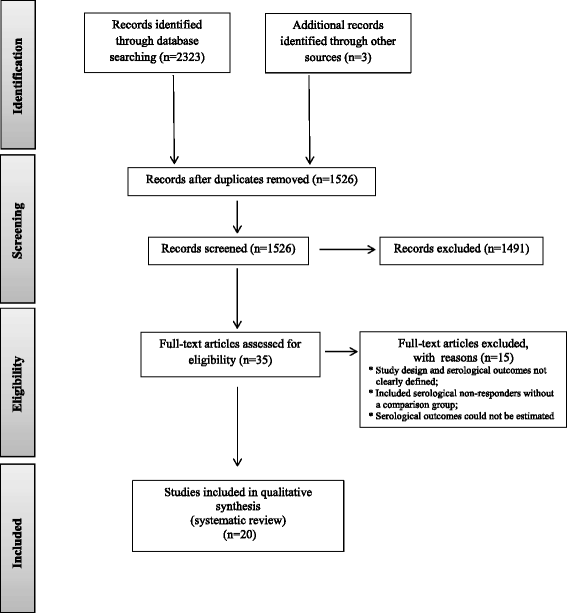A systematic review of syphilis serological treatment outcomes in HIV-infected and HIV-uninfected persons: rethinking the significance of serological non-responsiveness and the serofast state after therapy
- PMID: 26511465
- PMCID: PMC4625448
- DOI: 10.1186/s12879-015-1209-0
A systematic review of syphilis serological treatment outcomes in HIV-infected and HIV-uninfected persons: rethinking the significance of serological non-responsiveness and the serofast state after therapy
Abstract
Background: Syphilis remains a global public health threat and can lead to severe complications. In addition to resolution of clinical manifestations, a reduction in nontreponemal antibody titers after treatment is regarded as "proof of cure." However, some patients manifest < 4-fold decline ("serological non-response") or persistently positive nontreponemal titers despite an appropriate decline ("serofast") that may represent treatment failure, reinfection, or a benign immune response. To delineate these treatment phenomena, we conducted a systematic review of the literature regarding serological outcomes and associated factors among HIV-infected and -uninfected subjects.
Methods: Six databases (PubMed, Embase, CINAHL, Web of Science, Scopus, and BIOSIS) were searched with no date restrictions. Relevant articles that evaluated serological treatment responses and correlates of serological cure (≥ four-fold decline in nontreponemal titers) were included.
Results: We identified 1693 reports in the literature, of which 20 studies met selection criteria. The median proportion of patients who had serological non-response was 12.1% overall (interquartile range, 4.9-25.6), but varied depending on the time points after therapy. The serofast proportion could only be estimated from 2 studies, which ranged from 35.2-44.4%. Serological cure was primarily associated with younger age, higher baseline nontreponemal titers, and earlier syphilis stage. The relationship between serological cure and HIV status was inconsistent; among HIV-infected patients, CD4 count and HIV viral load was not associated with serological cure.
Conclusions: Serological non-response and the serofast state are common syphilis treatment outcomes, highlighting the importance of determining the immunological and clinical significance of persistent nontreponemal antibody titers after therapy.
Figures
Similar articles
-
Predictors of serological cure after treatment in patients with early syphilis: A retrospective observational study in Thailand.Indian J Dermatol Venereol Leprol. 2019 Mar-Apr;85(2):235. doi: 10.4103/ijdvl.IJDVL_810_17. Indian J Dermatol Venereol Leprol. 2019. PMID: 30719988
-
Lack of antiretroviral therapy is associated with higher risk of neurosyphilis among HIV-infected patients who remain serofast after therapy for early syphilis.Medicine (Baltimore). 2018 Nov;97(45):e13171. doi: 10.1097/MD.0000000000013171. Medicine (Baltimore). 2018. PMID: 30407349 Free PMC article.
-
Predictors of serofast state after treatment for early syphilis in HIV-infected patients.HIV Med. 2021 Mar;22(3):165-171. doi: 10.1111/hiv.12985. Epub 2020 Oct 30. HIV Med. 2021. PMID: 33128333
-
The serological dilemma: rethinking syphilis treatment evaluation.Expert Rev Anti Infect Ther. 2025 Feb-Apr;23(2-4):181-195. doi: 10.1080/14787210.2025.2467646. Epub 2025 Feb 18. Expert Rev Anti Infect Ther. 2025. PMID: 39945601 Review.
-
Potential Predictors for Serofast State after Treatment among HIV-Negative Persons with Syphilis in China: A Systematic Review and Meta-Analysis.Iran J Public Health. 2015 Feb;44(2):155-69. Iran J Public Health. 2015. PMID: 25905049 Free PMC article. Review.
Cited by
-
Laboratory Evaluation of the DPP Syphilis Screen & Confirm Assay.Microbiol Spectr. 2022 Jun 29;10(3):e0264221. doi: 10.1128/spectrum.02642-21. Epub 2022 May 31. Microbiol Spectr. 2022. PMID: 35638776 Free PMC article.
-
Serological Responses to Benzathine Penicillin-G Treatment in Early Syphilis Patients with Different HIV Status.Indian J Dermatol. 2021 Sep-Oct;66(5):575. doi: 10.4103/ijd.ijd_877_20. Indian J Dermatol. 2021. PMID: 35068535 Free PMC article. No abstract available.
-
Investigation of syphilis immunology and Treponema pallidum subsp. pallidum biology to improve clinical management and design a broadly protective vaccine: study protocol.BMC Infect Dis. 2020 Jun 23;20(1):444. doi: 10.1186/s12879-020-05141-0. BMC Infect Dis. 2020. PMID: 32576149 Free PMC article.
-
Changes of serofast status in HIV negative asymptomatic neurosyphilis patients after treatment.Front Med (Lausanne). 2022 Aug 3;9:938016. doi: 10.3389/fmed.2022.938016. eCollection 2022. Front Med (Lausanne). 2022. PMID: 35991658 Free PMC article.
-
Treatment Outcomes of Brazilian Inmates with Treponema pallidum and Human Immunodeficiency Virus Infection: A Prospective Cohort Study.Am J Trop Med Hyg. 2018 Jun;98(6):1603-1608. doi: 10.4269/ajtmh.17-0592. Epub 2018 May 3. Am J Trop Med Hyg. 2018. PMID: 29737273 Free PMC article.
References
-
- World Health Organization. Global incidence and prevalence of selected curable sexually transmitted infections—2008. World Health Organization, Geneva, Switzerland 2012. Last accessed on August 29,2015 at: http://apps.who.int/iris/bitstream/10665/75181/1/9789241503839_eng.pdf?ua=1.
Publication types
MeSH terms
Grants and funding
LinkOut - more resources
Full Text Sources
Other Literature Sources
Medical
Research Materials
Miscellaneous


